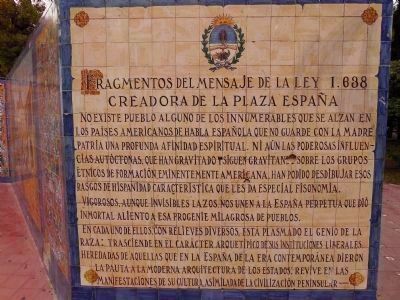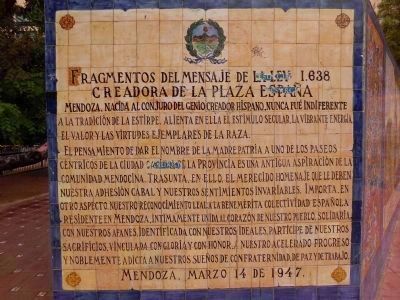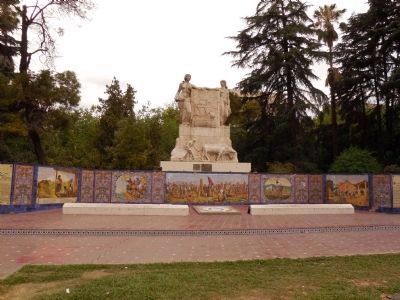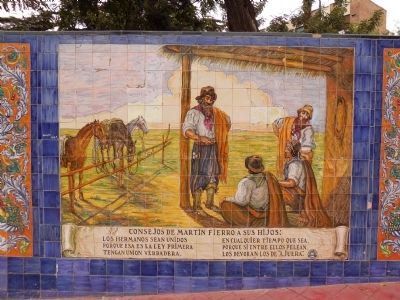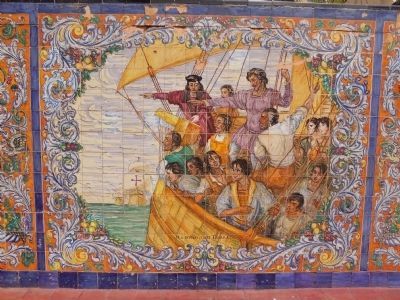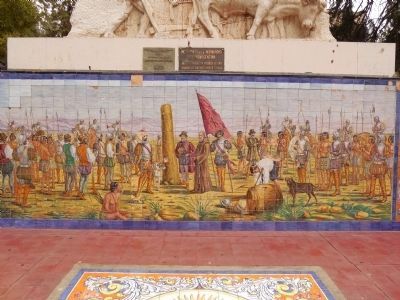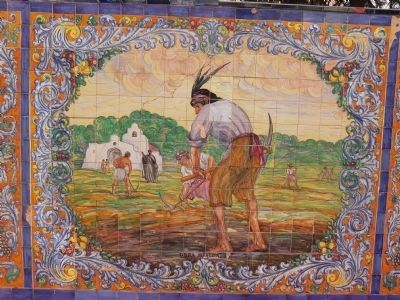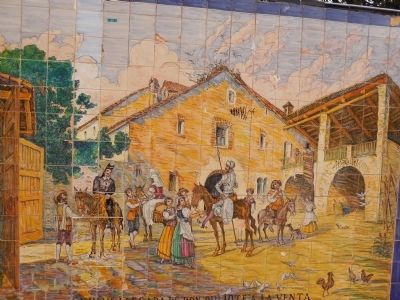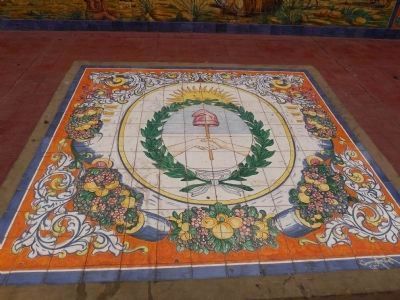Mendoza, Argentina — Southern South America
Monument to Hispanic-Argentine Brotherhood
Monumento a la Hermandad Hispano-Argentina
Inscription.
First part:
Fragmentos del mensaje de la ley 1.638.
Creadora de la plaza Espana. Mendoza.
No existe pueblo alguno de los innumerables que se alzan en los paises Americanos de habla espanola que no guarde con la madres partia una profunda afinidad spiritual ni aun las ponderosas influencias autoctonas. Que han gravitado y siguen gravitando sobre los grupos ethicos de formacion eminentemente Americana. Han podido desdibujar esos rasgos de hispanidad caracteristica que les da especial fisonomia. Vigorosos, aunque invisibles lazos. Nos unen a las Espana perpetua que dio inmortal aliento a esa progenie milagrosa de pueblos. En cada uno de ellos. Con relieves diversos. Esta plasmado el genio de La Raza: Transiende en el caracter arquetipico de sus instituciones liberales. Hereda das de aquellas que en la Espana de la era contemporanea dieron la paulta a la moderna arquitectura de los estados. Revive en las manifestaciones de cultural asimilada de la civilizacion peninsular.
Fragments of the Message of the Law 1.638 that created the Plaza of Espana.
There is no country in the Americas where Spanish is spoken from its beginnings which does not keep ties with the motherland’s spiritual influences of autonomy. The culture has gravitated and continues to gravitate above the ethnic groups of all countries of the Americas. No one has been able to erase the traits of their Spanish characteristics that give them their physical appearance. Strong but invisible ties join us to the immortal and perpetual Spain, giving breath to this miraculous progeny of people each with different embossing reflects the genius of race cuts in nature of liberal archetypal legacy of those institutions in perpetual Spain from the contemporary era that gave the standard for modern united architecture revived in the expressions of its culture of civilization assimilated in the mainland.
Second part:
Creadora de la plaza Espana. Mendoza.
Nacida al conjuro del genio creador hispano. Nunca fue indiferente a las tradicion de la estirpe. Alienta en ella el estimulo secular. La vibrante energia. El valor y lasvirtudes ejemplares de la raza. El pensamiento de mar el nombre de la madre patria a uno de los paseos gentricos de laciudad. De la provincial es una Antigua aspiracion de la comunidad mendocina. Trasunta, en ello,el mericido homenaje que le deben nuestra
adhesion cabal y nuestros sentimientos invariables. Importa enotro aspect. Nuestro reconocimiento leala a la benemerita colectividad espanola residente en Mendoza. Intimamente unida al corazon de nuestro puerlo solidaria con nuestros afanes, identificada con nuestros ideales, participle de nuestros sacrificios. Vinculada con Gloria y con honor. Nuestro acelerado progreso y noblemente adicta a nuestros suenos de confraternidad, de paz, y de trabajo. Mendoza. Marzo 14 de 1947
Fragments of message 1,638 law.
Creator of the Plaza España.
Mendoza, born under the spell of Hispanic creative genius, was never indifferent to the tradition of the race. It encourages the secular stimulus, the vibrant energy, the value and virtues of the breed. The thought to give the name of the mother country to one of the parks in the capital city of the province is an old aspiration of the Mendoza community. The reason why is the tribute they owe our full adhesion and our invariable feelings. Another aspect is our loyal recognition of the meritorious Spanish community. Mendoza is intimately linked to the heart of our people. Solidarity with our efforts, identified with our ideals, part of our sacrifices linked with glory and honor, our rapid progress, and noble part of our dreams of brotherhood, peace and work.
MENDOZA, MARCH
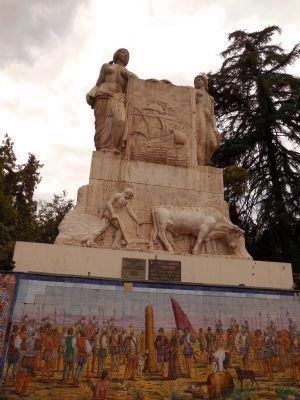
Photographed By Marsha A. Matson, November 20, 2014
3. Monumento a la Hermandad Hispano-Argentina Marker
solares del Cid Campeador en España
y del Gral. San Martin en Yapeyu.
Erected 1947.
Topics. This historical marker is listed in these topic lists: Arts, Letters, Music • Settlements & Settlers. A significant historical date for this entry is March 14, 1932.
Location. 32° 53.567′ S, 68° 50.517′ W. Marker is in Mendoza. Marker can be reached from Montevideo. A brass marker is just located below the statue, on top of the tile friezes. Two ceramic tile markers are located on each end of the monument, located in Plaza de Espana, a park at Avenida de Espana, Calle Montevideo, Calle 9 de julio and Calle San Lorenzo. The monument represents Argentina’s patriotic Spanish roots. In addition to the three markers, the monument has beautiful ceramic tile murals, a ceramic tile symbol of Argentina on the ground in front of the murals, and two levels of statues atop the murals. Touch for map. Marker is at or near this postal address: Montevideo 200, Mendoza M5500, Argentina. Touch for directions.
Other nearby markers. At least 1 other marker is within 5 kilometers of this marker, measured as the crow flies. The Hill of Glory (approx. 4.6 kilometers away).
Regarding Monument to Hispanic-Argentine Brotherhood. The Plaza de Espana was built after the city was devastated by an 1861 earthquake. The monument was prsented to the city on March 11, 1949. It is constructed of travertine marble and ceramic
tiles. The statue at the top is composed of two parts: The topmost part is of two women, one a symbol of Spain and the other of a young woman, a symbol of Argentina. Connecting them are Columbus's ships. The lower level of the statue is a farmer plowing with oxen. Below the statue is a base composed of scenes of colorful tiles depicting historic moments important to Mendoza, Argentina, including Columbus's discovery of America, the founding of Mendoza, Native Americans working at a mission, a scene from Martin Fierro, an epic Argentine poem, and a scene from Don Quijote, a Spanish literary classic.
Credits. This page was last revised on March 10, 2018. It was originally submitted on December 22, 2014, by Marsha A. Matson of Palmetto Bay, Florida. This page has been viewed 615 times since then and 20 times this year. Photos: 1, 2, 3, 4, 5, 6, 7, 8, 9, 10. submitted on December 22, 2014, by Marsha A. Matson of Palmetto Bay, Florida. • Andrew Ruppenstein was the editor who published this page.
